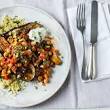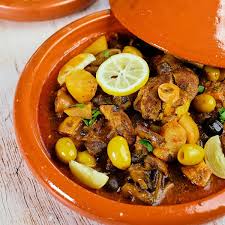Exploring the Delights of a Moroccan Meal
When it comes to culinary experiences that tantalize the taste buds and transport you to a world of vibrant flavours, few cuisines can rival the richness and diversity of Moroccan food. A traditional Moroccan meal is not just about sustenance; it’s a sensory journey that reflects centuries of cultural influences and culinary expertise.
The Essence of Moroccan Cuisine
At the heart of every Moroccan meal is the concept of sharing and hospitality. Meals are often enjoyed with family and friends, with dishes served communally in large platters or tagines. The blend of sweet and savoury flavours, aromatic spices, and tender meats or vegetables create a symphony of tastes that leave a lasting impression.
Key Ingredients
Moroccan cuisine is known for its use of ingredients such as couscous, preserved lemons, olives, almonds, and an array of spices like cumin, cinnamon, saffron, and paprika. These ingredients come together to create dishes that are both comforting and exotic.
Signature Dishes
One cannot talk about Moroccan cuisine without mentioning iconic dishes like tagine—a slow-cooked stew made with meat or vegetables, flavoured with spices and dried fruits. Couscous is another staple dish that is steamed to perfection and served with a variety of toppings ranging from tender lamb to colourful vegetables.
The Ritual of Mint Tea
No Moroccan meal is complete without a refreshing glass of mint tea. This sweetened green tea infused with fresh mint leaves is not just a drink but a symbol of hospitality in Moroccan culture. It is often served before or after meals as a gesture of welcome and friendship.
Experience the Magic
Whether you’re savouring a steaming bowl of harira soup during Ramadan or indulging in pastilla—a delicate pastry filled with spiced meat and nuts—each bite of a Moroccan meal tells a story steeped in tradition and innovation. The next time you sit down to enjoy this culinary delight, remember that you’re not just eating; you’re partaking in an ancient ritual that celebrates community, flavour, and heritage.
Exploring Moroccan Cuisine: Traditional Meals, National Dishes, and Popular Foods
- What is a traditional moroccan meal?
- What is typical Moroccan food?
- What is the traditional way of eating in Morocco?
- What is the Moroccan food menu?
- What is Morocco’s national dish?
- What is the national dish of Morocco?
- What are 3 popular foods in Morocco?
- What is a Moroccan feast?
What is a traditional moroccan meal?
A traditional Moroccan meal is a feast for the senses, encompassing a harmonious blend of flavours, textures, and aromas that reflect the country’s rich culinary heritage. At the heart of a traditional Moroccan meal is the concept of sharing and communal dining, where dishes are served in large platters or tagines to be enjoyed together with family and friends. Key ingredients such as couscous, aromatic spices like cumin and cinnamon, and tender meats or vegetables come together to create iconic dishes like tagine and couscous. The ritual of mint tea often accompanies these meals, symbolising hospitality and warmth in Moroccan culture. Each bite of a traditional Moroccan meal is a journey into the country’s vibrant food traditions, inviting diners to experience the depth of flavour and tradition that define Moroccan cuisine.
What is typical Moroccan food?
One of the most frequently asked questions about Moroccan cuisine is, “What is typical Moroccan food?” The answer lies in the diverse array of dishes that reflect the country’s rich culinary heritage. From fragrant tagines packed with succulent meats, vegetables, and dried fruits to fluffy couscous adorned with a medley of toppings, such as spicy harissa or tender lamb, Moroccan food embodies a harmonious blend of sweet and savoury flavours. Traditional dishes like pastilla, a delicate pastry filled with seasoned meat and nuts, and refreshing mint tea served with every meal showcase the depth of flavours and hospitality that define Moroccan gastronomy.
What is the traditional way of eating in Morocco?
In Morocco, the traditional way of eating is a communal and sociable affair that reflects the country’s rich cultural heritage. Meals are often shared with family and friends, with dishes placed in the centre of the table for everyone to enjoy together. The customary practice involves using the right hand for eating, as the left hand is considered unclean. Moroccans typically eat with bread, using it to scoop up food or as a utensil. The emphasis is on savouring each bite, engaging in lively conversation, and embracing the spirit of hospitality that defines Moroccan dining experiences.
What is the Moroccan food menu?
The Moroccan food menu is a vibrant tapestry of flavours and textures that reflect the country’s diverse culinary heritage. From fragrant tagines to fluffy couscous, the menu offers a tantalising array of dishes that blend sweet and savoury notes with a harmonious mix of spices. Traditional Moroccan cuisine often includes dishes like lamb tagine with apricots, couscous with seven vegetables, and pastilla—a savoury pie filled with spiced meat and nuts. Each dish on the Moroccan food menu tells a story of ancient traditions, warm hospitality, and a deep connection to the land and its people.
What is Morocco’s national dish?
One of the most frequently asked questions about Moroccan cuisine is, “What is Morocco’s national dish?” While Morocco boasts a rich tapestry of culinary delights, one dish stands out as a symbol of the country’s gastronomic heritage—tagine. This slow-cooked stew, named after the earthenware pot in which it is traditionally prepared, features a tantalising blend of tender meat or vegetables, aromatic spices, and dried fruits. Tagine encapsulates the essence of Moroccan cooking with its harmonious fusion of sweet and savoury flavours, making it a beloved and iconic dish that represents the heart and soul of Moroccan culinary tradition.
What is the national dish of Morocco?
One of the most frequently asked questions about Moroccan cuisine is, “What is the national dish of Morocco?” While Morocco boasts a diverse and rich culinary heritage, one dish often hailed as its national treasure is the tagine. This slow-cooked stew, named after the earthenware pot in which it is cooked, features a tantalising blend of tender meats or vegetables, aromatic spices, and dried fruits. The tagine encapsulates the essence of Moroccan cuisine with its harmonious combination of sweet and savoury flavours, making it a beloved symbol of Moroccan culinary tradition.
What are 3 popular foods in Morocco?
Morocco boasts a rich tapestry of culinary delights that reflect its diverse cultural influences. When exploring the popular foods of Morocco, three standout dishes often grace the tables across the country. Firstly, tagine, a slow-cooked stew typically made with tender meat or vegetables, fragrant spices, and dried fruits, is a beloved Moroccan classic known for its depth of flavour. Secondly, couscous, a staple grain dish steamed to fluffy perfection and served with an array of toppings such as succulent lamb or vibrant vegetables, holds a special place in Moroccan cuisine. Lastly, mint tea, a sweetened green tea infused with fresh mint leaves, is not just a beverage but an integral part of Moroccan hospitality and social gatherings. These three iconic foods encapsulate the essence of Moroccan gastronomy and are must-try dishes for anyone seeking to savour the authentic flavours of this enchanting North African country.
What is a Moroccan feast?
A Moroccan feast, known as a “feast of flavours,” is a culinary extravaganza that embodies the essence of Moroccan hospitality and culture. It is a grand celebration of food, family, and tradition where an array of sumptuous dishes are served in abundance. A typical Moroccan feast often includes iconic dishes like tagines filled with tender meats or vegetables, fragrant couscous topped with a medley of ingredients, and sweet pastries that melt in your mouth. The feast is not just about the food but also about the experience—bringing people together to share in the joy of good company and exquisite flavours that have been passed down through generations.



